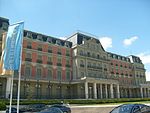Emmanuel Episcopal Church (Geneva)
Buildings and structures in GenevaChurches in GenevaEpiscopal (ECUSA) church buildings in EuropeReligious buildings and structures in Geneva

Emmanuel Episcopal Church, located in Geneva, Switzerland, is an English speaking Episcopal parish of the Convocation of Episcopal Churches in Europe, and a member of the Anglican Communion. The church has previously been known as "The American Church" (and informally as "The American Chapel"), but this designation was abandoned in 1977 in the light of the decreasing American participation in the congregation. In December 1924 the church was established as a charitable foundation under Swiss law: La Fondation de la Chappelle d'Emmanuel.
Excerpt from the Wikipedia article Emmanuel Episcopal Church (Geneva) (License: CC BY-SA 3.0, Authors, Images).Emmanuel Episcopal Church (Geneva)
Rue de-Monthoux, Geneva Les Pâquis
Geographical coordinates (GPS) Address Nearby Places Show on map
Geographical coordinates (GPS)
| Latitude | Longitude |
|---|---|
| N 46.209847222222 ° | E 6.1499194444444 ° |
Address
Emmanuel Church
Rue de-Monthoux
1201 Geneva, Les Pâquis
Geneva, Switzerland
Open on Google Maps










